Free Sugar Content in Pre-Packaged Products: Does Voluntary Product Reformulation Work in Practice?
Abstract
:1. Introduction
2. Material and Methods
2.1. Data Collection 2015 and 2017
2.2. Calculation of Total and Free Sugar Content
2.3. Sales-Weighted Total and Free Sugar Content
2.4. Share in Free Sugar Sales
2.5. 2015–2017 Comparison between On-Shelf Availability and Sales Depending on Free Sugar Content
2.6. Data Accuracy
2.7. Statistical Analysis
3. Results
3.1. A Median Total and Free Sugar Content in Different Food Categories 2017
3.2. Trends in Sales-Adjusted Mean Free Sugar Content in Different Food Categories between 2015 and 2017
3.3. Share in Free Sugar Sales
3.4. On-Shelf Availability and Sales of Products with Different Free Sugar Content in 2015 and 2017
4. Discussion
5. Conclusions
Supplementary Materials
Author Contributions
Funding
Acknowledgments
Conflicts of Interest
References
- Monteiro, C.A.; Levy, R.B.; Claro, R.M.; de Castro, I.R.R.; Cannon, G. Increasing consumption of ultra-processed foods and likely impact on human health: Evidence from Brazil. Public Health Nutr. 2010, 14, 5–13. [Google Scholar] [CrossRef] [PubMed]
- Monteiro, C.A.; Cannon, G.; Levy, R.; Moubarac, J.C.; Jaime, P.; Martins, A.P.; Canella, D.; Louzada, M.; Parra, D. NOVA. The Star Shines Bright. World Nutr. 2016, 7, 28–38. [Google Scholar]
- Monteiro, C.A.; Cannon, G.; Moubarac, J.C.; Levy, R.B.; Louzada, M.L.C.; Jaime, P.C. The UN Decade of Nutrition, the NOVA food classification and the trouble with ultra-processing. Public Health Nutr. 2018, 21, 5–17. [Google Scholar] [CrossRef] [PubMed]
- Dunford, E.K.; Ni Mhurchu, C.; Huang, L.; Vandevijvere, S.; Swinburn, B.; Pravst, I.; Tolentino-Mayo, L.; Reyes, M.; L’Abbe, M.; Neal, B.C. A comparison of the healthiness of packaged foods and beverages from 12 countries using the Health Star Rating nutrient profiling system, 2013–2018. Obes. Rev. 2019. [Google Scholar] [CrossRef]
- Monteiro, C.A.; Moubarac, J.C.; Levy, R.B.; Canella, D.S.; da Costa Louzada, M.L.; Cannon, G. Household availability of ultra-processed foods and obesity in nineteen European countries. Public Health Nutr. 2018, 21, 18–26. [Google Scholar] [CrossRef]
- Nardocci, M.; Leclerc, B.S.; Louzada, M.L.; Monteiro, C.A.; Batal, M.; Moubarac, J.C. Consumption of ultra-processed foods and obesity in Canada. Can. J. Public Health 2019, 110, 4–14. [Google Scholar] [CrossRef]
- Steele, E.M.; Baraldi, L.G.; da Costa Louzada, M.L.; Moubarac, J.C.; Mozaffarian, D.; Monteiro, C.A. Ultra-processed foods and added sugars in the US diet: Evidence from a nationally representative cross-sectional study. BMJ Open 2016, 6, e009892. [Google Scholar] [CrossRef]
- Moubarac, J.-C.; Batal, M.; Louzada, M.L.; Steele, E.M.; Monteiro, C.A. Consumption of ultra-processed foods predicts diet quality in Canada. Appetite 2017, 108, 512–520. [Google Scholar] [CrossRef]
- Koiwai, K.; Takemi, Y.; Hayashi, F.; Ogata, H.; Matsumoto, S.; Ozawa, K.; Machado, P.P.; Monteiro, C.A. Consumption of ultra-processed foods decreases the quality of the overall diet of middle-aged Japanese adults. Public Health Nutr. 2019, 22, 1–10. [Google Scholar] [CrossRef]
- Da Costa Louzada, M.L.; Ricardo, C.Z.; Steele, E.M.; Levy, R.B.; Cannon, G.; Monteiro, C.A. The share of ultra-processed foods determines the overall nutritional quality of diets in Brazil. Public Health Nutr. 2018, 21, 94–102. [Google Scholar] [CrossRef]
- WHO. Guideline: Sugars Intake for Adults and Children. 2015. Available online: http://www.who.int/nutrition/publications/guidelines/sugars_intake/en (accessed on 23 August 2019).
- Zupanič, N.; Miklavec, K.; Kušar, A.; Žmitek, K.; Fidler Mis, N.; Pravst, I. Total and Free Sugar Content of Pre-Packaged Foods and Non-Alcoholic Beverages in Slovenia. Nutrients 2018, 10, 151. [Google Scholar] [CrossRef] [PubMed]
- Fidler Mis, N.; Braegger, C.; Bronsky, J.; Campoy, C.; Domellöf, M.; Embleton, N.D.; Hojsak, I.; Hulst, J.; Indrio, F.; Lapillonne, A.; et al. Sugar in infants, children and adolescents: A position paper of the ESPGHAN Committee on Nutrition. J. Pediatr. Gastroenterol. Nutr. 2017, 65, 681–696. [Google Scholar] [CrossRef] [PubMed]
- Vos, M.B.; Kaar, J.L.; Welsh, J.A.; Van Horn, L.V.; Feig, D.I.; Anderson, C.A.; Patel, M.J.; Cruz Munos, J.; Krebs, N.F.; Xanthakos, S.A.; et al. Added Sugars and Cardiovascular Disease Risk in Children A Scientific Statement From the American Heart Association. Circulation. 2017, 135, e1017–e1034. [Google Scholar] [CrossRef] [PubMed]
- RS. Resolution on National Programme on Nutrition and Physical Activity 2015–2025 (In Slovenian: Resolucija o Nacionalnem Programu o Prehrani in Telesni Dejavnosti za Zdravje 2015–2025). 2015. Available online: http://www.mz.gov.si/fileadmin/mz.gov.si/pageuploads/javna_razprava_2015/Resolucija_o_nac_programu_prehrane_in_in_tel_dejavnosti_jan_2015.pdf (accessed on 24 August 2019).
- Nutrition Institute, Ljubljana, Slovenia. CLAS—Composition and Labelling Information System as a Tool for Monitoring of the Food Supply. 2019. Available online: https://www.nutris.org/en/composition-and-labelling-information-system (accessed on 20 August 2019).
- Dunford, E.; Webster, J.; Metzler, A.B.; Czernichow, S.; Mhurchu, C.N.; Wolmarans, P.; Snowdon, W.; L’Abbe, M.; Li, N.; Maulik, P.K.; et al. International collaborative project to compare and monitor the nutritional composition of processed foods. Eur. J. Prev. Cardiol. 2012, 19, 1326–1332. [Google Scholar] [CrossRef] [PubMed]
- Bernstein, J.T.; Schermel, A.; Mills, C.; L’Abbé, M. Total and free sugar content of Canadian prepackaged foods and beverages. Nutrients 2016, 8, 582. [Google Scholar] [CrossRef] [PubMed]
- Lavriša, Ž.; Erjavec, K.; Pravst, I. Trends in marketing foods to children in Slovenian magazines: A content analysis. Public Health Nutr. 2018, 21, 3344–3353. [Google Scholar] [CrossRef]
- Kelly, B.; Vandevijvere, S.; Ng, S.; Adams, J.; Allemandi, L.; Bahena-Espina, L.; Barquera, S.; Boyland, E.; Calleja, P.; Carmona-Garcés, I.C. Global benchmarking of children’s exposure to television advertising of unhealthy foods and beverages across 22 countries. Obes. Rev. 2019. [Google Scholar] [CrossRef]
- Pravst, I.; Lavriša, Ž.; Kušar, A.; Miklavec, K.; Žmitek, K. Changes in Average Sodium Content of Prepacked Foods in Slovenia during 2011–2015. Nutrients 2017, 9, 952. [Google Scholar] [CrossRef]
- Ronit, K.; Jensen, J.D. Obesity and industry self-regulation of food and beverage marketing: A literature review. Eur. J. Clin. Nutr. 2014, 68, 753. [Google Scholar] [CrossRef]
- Scrinis, G.; Monteiro, C.A. Ultra-processed foods and the limits of product reformulation. Public Health Nutr. 2018, 21, 247–252. [Google Scholar] [CrossRef]
- Monteiro, C.; Cannon, G. The Food System. Ultra-processing. Product reformulation will not improve public health. World Nutr. 2012, 3, 406–434. [Google Scholar]
- Niebylski, M.L.; Redburn, K.A.; Duhaney, T.; Campbell, N.R. Healthy food subsidies and unhealthy food taxation: A systematic review of the evidence. Nutrition 2015, 31, 787–795. [Google Scholar] [CrossRef] [PubMed]
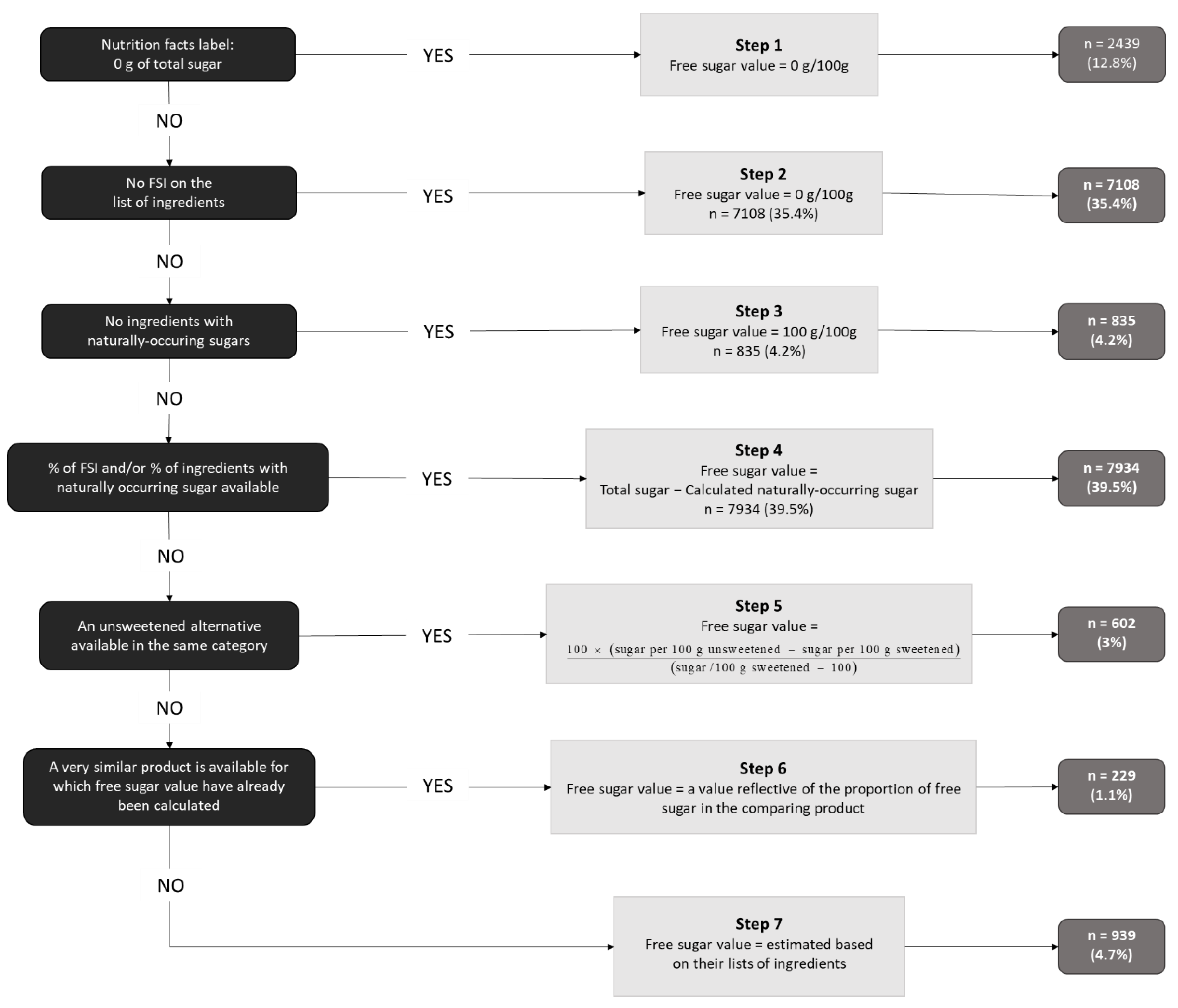
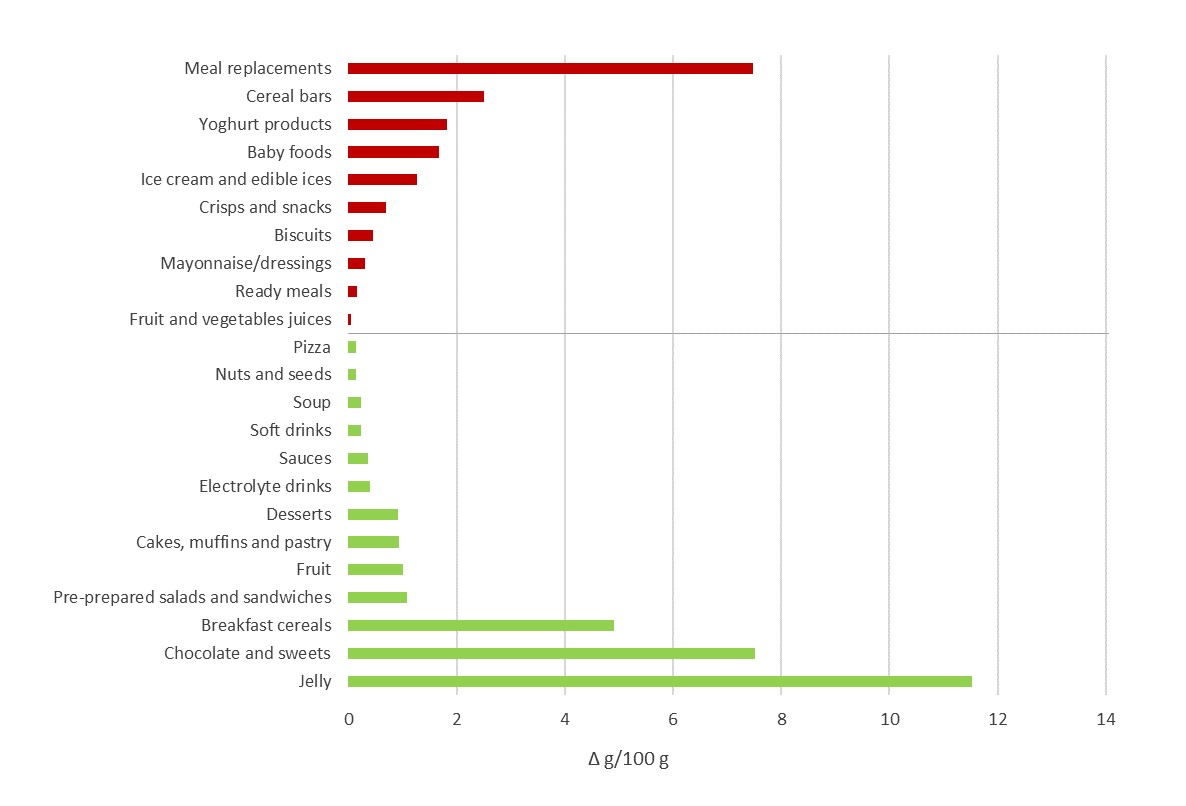
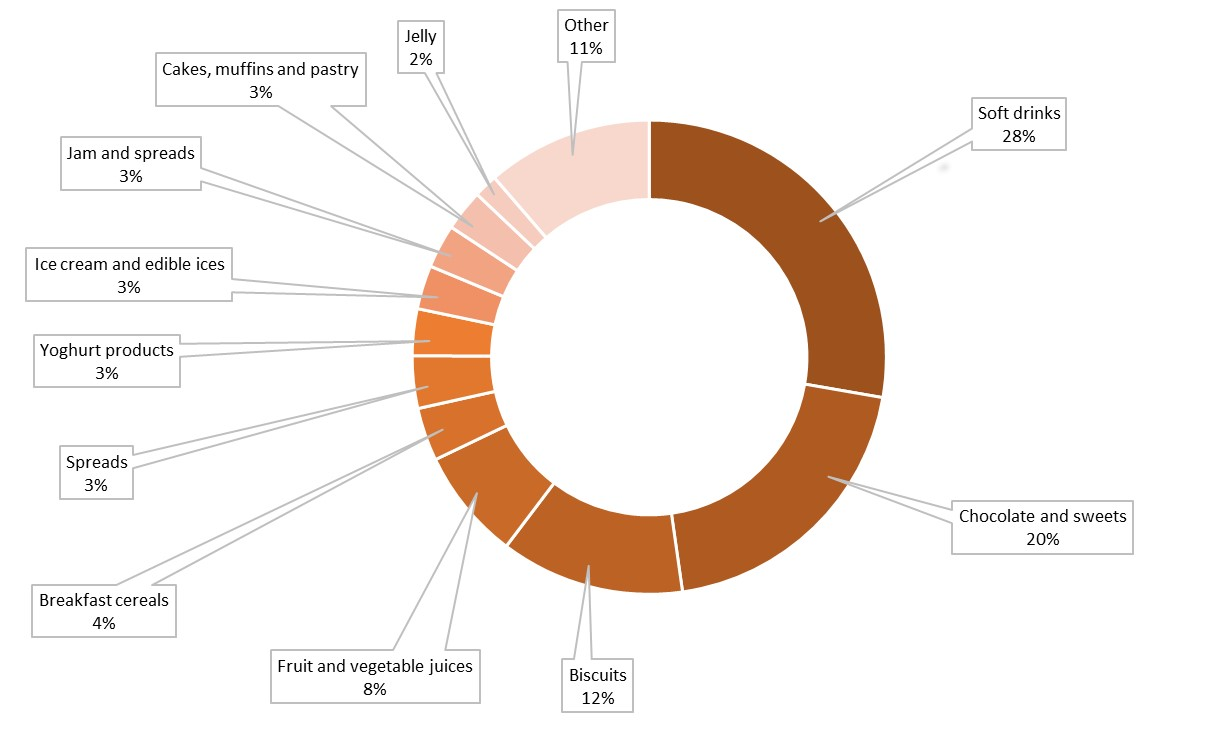
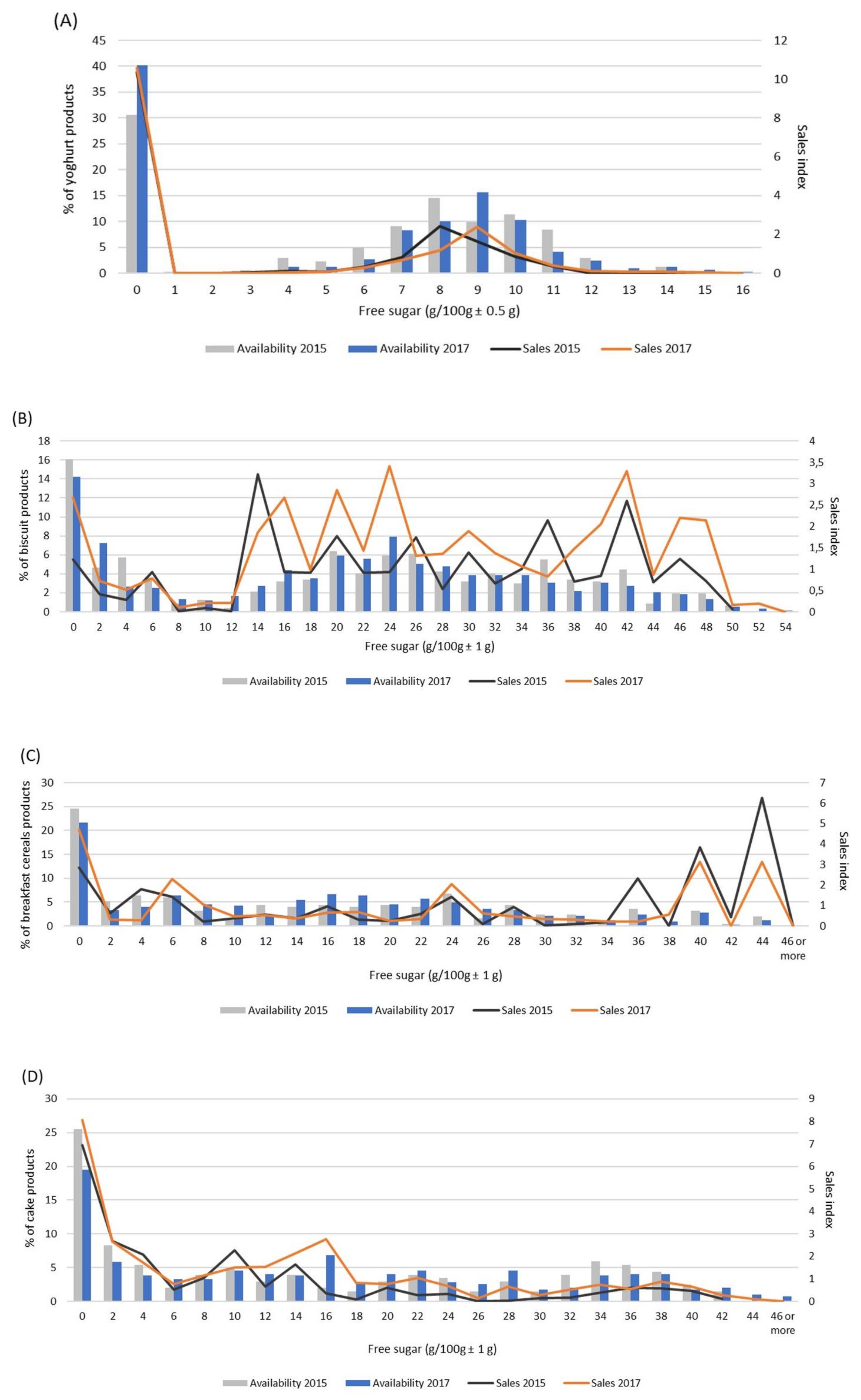
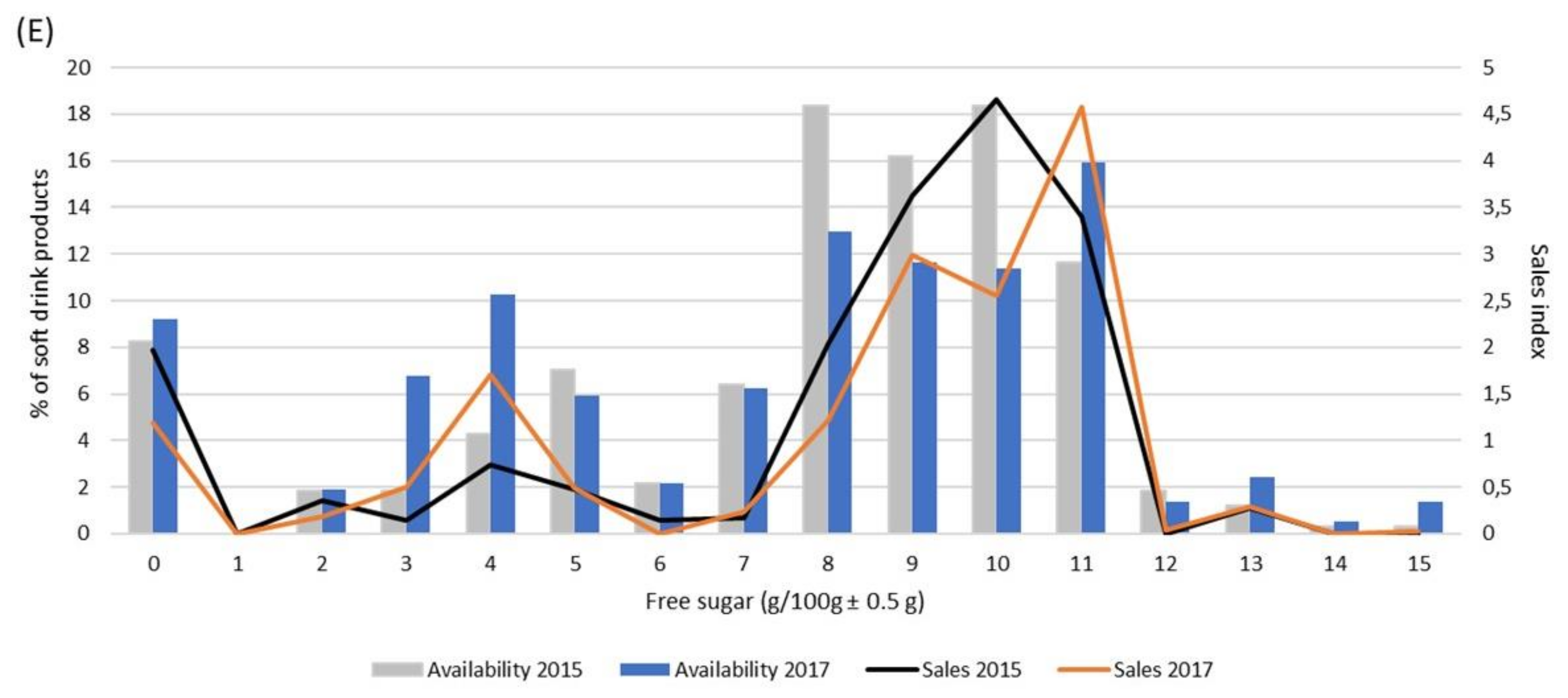
| Food Category | n | Total Sugar (g/100 g or g/100 mL) | Free Sugar (g/100 g or g/100 mL) | Free Sugar (% of total sugar) | ||||||||||
|---|---|---|---|---|---|---|---|---|---|---|---|---|---|---|
| Mean (SD) | Min | 25th | 50th | 75th | Max | Mean (SD) | Min | 25th | 50th | 75th | Max | |||
| Baby foods | 216 | 14.5 (17) | 0 | 7.9 | 10 | 12.7 | 94 | 10.2 (17.2) | 0 | 0 | 6.7 | 10.7 | 94 | 56.7 |
| Biscuits | 1302 | 24.0 (14.9) | 0 | 12.7 | 25 | 35.2 | 77 | 22.2 (14.8) | 0 | 8.8 | 23.4 | 33 | 75.1 | 82.8 |
| Bread | 224 | 3.4 (2.8) | 0.2 | 1.6 | 2.6 | 4.1 | 19 | 2.1 (3) | 0 | 0 | 2.6 | 3.3 | 6.6 | 61.9 |
| Breakfast cereals | 443 | 17.7 (11.3) | 0 | 7.7 | 18.8 | 25 | 45 | 14.5 (11.8) | 0 | 3.4 | 14.2 | 22.7 | 44.4 | 67.1 |
| Butter and margarine | 128 | 0.5 (0.6) | 0 | 0 | 0.5 | 0.6 | 3.9 | 0 (0.1) | 0 | 0 | 0 | 0 | 0.8 | 1.3 |
| Cakes, muffins, and pastry | 601 | 20.8 (13.1) | 0.4 | 14 | 22.5 | 33.5 | 60 | 21.9 (12.1) | 0 | 11.7 | 21 | 31.8 | 59.9 | 89.2 |
| Canned fish and seafood | 304 | 0.9 (1.5) | 0 | 0 | 0 | 1.5 | 7.4 | 0.5 (1.1) | 0 | 0 | 0 | 0 | 7.1 | 14.1 |
| Cereal bars | 68 | 29.6 (6.1) | 1.8 | 27 | 30.9 | 33.4 | 40 | 27 (5.6) | 1.2 | 23.1 | 28.3 | 31 | 35.5 | 91.2 |
| Cheese | 842 | 2.0 (3) | 0 | 0.1 | 1 | 3 | 33 | 0.1 (1.4) | 0 | 0 | 0 | 0 | 28 | 1.1 |
| Chewing gum | 96 | 4.2 (17.3) | 0 | 0 | 0 | 0 | 86 | 4 (17.2) | 0 | 0 | 0 | 0 | 86 | 5.2 |
| Chilled fish | 37 | 0.4 (0.7) | 0 | 0 | 0.4 | 0.6 | 3.8 | 0.1 (0.6) | 0 | 0 | 0 | 0 | 3.7 | 8.1 |
| Chocolate and sweets | 1853 | 50.8 (17.3) | 0 | 43.1 | 51.1 | 59 | 100 | 49.5 (18.8) | 0 | 39.4 | 48.0 | 57.1 | 100 | 93 |
| Coffee and tea | 1063 | 7.1 (17.9) | 0 | 0 | 0 | 0 | 89 | 5.3 (15.9) | 0 | 0 | 0 | 0 | 89 | 12 |
| Cooking oils | 420 | 0 (0) | 0 | 0 | 0 | 0 | 0 | 0 (0) | 0 | 0 | 0 | 0 | 0 | 0 |
| Cordials | 140 | 31.7 (15.6) | 0 | 9.0 | 10.3 | 52.2 | 88 | 31.7 (15.6) | 0 | 9.0 | 10.3 | 52.2 | 88 | 100 |
| Couscous | 21 | 2.06 (0.8) | 0.8 | 1.7 | 2.2 | 2.5 | 4.1 | 0.1 (0.6) | 0 | 0 | 0 | 0 | 2.5 | 4.4 |
| Cream | 161 | 4.5 (3.9) | 0 | 3 | 3.4 | 4.2 | 39 | 1.5 (4.2) | 0 | 0 | 0 | 0 | 39 | 15.5 |
| Crisps and snacks | 435 | 2.9 (3.5) | 0 | 1 | 2 | 3.4 | 41.3 | 1.7 (2.9) | 0 | 0 | 0.7 | 2.5 | 35.6 | 40.6 |
| Desserts | 277 | 13.9 (10.6) | 0 | 9.8 | 13 | 15 | 74 | 10.3 (10) | 0 | 6 | 9.7 | 12.1 | 73.4 | 63.6 |
| Eggs | 83 | 0 (0) | 0 | 0 | 0 | 0 | 0 | 0 (0) | 0 | 0 | 0 | 0 | 0 | 0 |
| Electrolyte drinks | 27 | 16.3 (25.5) | 0 | 3.9 | 4.2 | 6 | 75 | 16.3 (25.5) | 0 | 3.9 | 4.2 | 6 | 75 | 92.6 |
| Frozen fish | 116 | 0.7 (1) | 0 | 0 | 0.5 | 1 | 4.2 | 0.3 (0.9) | 0 | 0 | 0 | 0 | 4.1 | 16.5 |
| Fruits | 413 | 35.4 (24.4) | 0 | 12.8 | 30.5 | 59 | 88 | 10.7 (19.6) | 0 | 0 | 0 | 10.6 | 79.1 | 29.2 |
| Fruit and vegetables juices | 457 | 9 (3) | 0 | 8 | 9.7 | 11 | 16 | 9.0 (3) | 0 | 8 | 9.7 | 11 | 16 | 99.6 |
| Honey and syrups | 197 | 86.6 (15.3) | 21 | 79.5 | 95 | 99 | 100 | 86.6 (15.3) | 21 | 79.5 | 95 | 99 | 100 | 100 |
| Ice cream and edible ices | 395 | 24 (6.3) | 10 | 21 | 24 | 26.8 | 76 | 21 (6.6) | 0 | 18.5 | 21.8 | 24.1 | 61 | 87.4 |
| Jam and spreads | 333 | 48.1 (13.6) | 2 | 38.2 | 50 | 58.3 | 82.2 | 43.2 (15.9) | 0 | 32.9 | 45.2 | 54.5 | 79 | 87.4 |
| Jelly | 144 | 56.2 (9.7) | 39 | 47.2 | 54 | 64 | 82 | 56.2 (9.7) | 39 | 47.2 | 54 | 64 | 82 | 100 |
| Maize (Corn) | 5 | 2.6 (1.5) | 0 | 1.4 | 2.5 | 3.95 | 5.4 | 0.9 (1.1) | 0 | 0 | 0 | 2.3 | 2.3 | 36.5 |
| Mayonnaise/dressings | 104 | 4.1 (3.5) | 0.2 | 1.5 | 2.7 | 6 | 17 | 3.7 (3.4) | 0 | 1.3 | 2.4 | 5.3 | 17 | 87.3 |
| Meal replacements | 29 | 13.3 (7.7) | 0.5 | 6.8 | 13.4 | 18.7 | 36.5 | 11.4 (7.7) | 0 | 5.9 | 11.3 | 16.9 | 33.5 | 76.1 |
| Meat alternatives | 111 | 1.8 (2.9) | 0 | 0.2 | 0.5 | 1.83 | 13 | 0.3 (0.8) | 0 | 0 | 0 | 0 | 5.8 | 15.8 |
| Milk | 321 | 6.1 (6) | 0 | 4.4 | 4.8 | 6.5 | 55 | 2.2 (5.6) | 0 | 0 | 0 | 2.9 | 51 | 24.6 |
| Noodles | 147 | 2.4 (1.5) | 0 | 1.2 | 2.8 | 3.6 | 6.2 | 0 (0) | 0 | 0 | 0 | 0 | 0 | 0 |
| Nuts and seeds | 398 | 9.1 (13.1) | 0 | 1.88 | 4.3 | 6.9 | 69 | 2.7 (8.2) | 0 | 0 | 0 | 0 | 55.7 | 6.1 |
| Pasta | 635 | 2.7 (1.6) | 0 | 1.4 | 3 | 3.7 | 13.8 | 0.1 (0.5) | 0 | 0 | 0 | 0 | 4.1 | 2.2 |
| Pizza | 52 | 3.2 (1.2) | 1.3 | 2.3 | 3.2 | 4.2 | 5.4 | 2.3 (1.2) | 1.2 | 1.4 | 2.3 | 3.1 | 4.7 | 69.9 |
| Pre-prepared salads and sandwiches | 36 | 2.8 (1.9) | 0 | 1.2 | 2.5 | 3.4 | 7.8 | 1.8 (1.5) | 0 | 0.6 | 1.3 | 2.4 | 5.6 | 59.9 |
| Processed meat and derivatives | 1558 | 0.5 (0.5) | 0 | 0.1 | 0.5 | 0.5 | 5.6 | 0.3 (0.5) | 0 | 0 | 0.1 | 0.5 | 5.6 | 54 |
| Ready meals | 355 | 2.4 (2.3) | 0 | 0.9 | 1.9 | 3.3 | 15.6 | 1 (1.8) | 0 | 0 | 0.2 | 1.4 | 12.3 | 34.6 |
| Rice | 158 | 0 (0) | 0 | 0 | 0 | 0 | 0 | 0 (0) | 0 | 0 | 0 | 0 | 0 | 0 |
| Sauces | 687 | 10.3 (12.7) | 0 | 2.5 | 5.3 | 11.6 | 65 | 7.5 (12.5) | 0 | 0 | 2 | 7 | 64.8 | 47 |
| Soft drinks | 529 | 7.1 (4.2) | 0 | 4.1 | 8 | 10 | 37 | 7.1 (4.2) | 0 | 4.1 | 8 | 10 | 37 | 89.2 |
| Soup | 189 | 0.6 (0.7) | 0 | 0.3 | 0.5 | 0.8 | 3.7 | 0.4 (0.5) | 0 | 0 | 0.2 | 0.5 | 3.5 | 89.2 |
| Spreads | 496 | 10.2 (19) | 0 | 0.5 | 1.1 | 5.5 | 64.3 | 8.3 (17.6) | 0 | 0 | 0.2 | 2 | 58.5 | 41.6 |
| Unprocessed cereals | 399 | 1.6 (2.1) | 0 | 0.7 | 1.2 | 2 | 26.3 | 0.2 (1.4) | 0 | 0 | 0 | 0 | 24 | 2.7 |
| Vegetables | 997 | 3 (4.7) | 0 | 0.4 | 1.6 | 3.9 | 49 | 0.5 (2.5) | 0 | 0 | 0 | 0 | 36.1 | 10.1 |
| Waters | 132 | 0 (0) | 0 | 0 | 0 | 0 | 0 | 0 (0) | 0 | 0 | 0 | 0 | 0 | 0 |
| Yoghurt products | 722 | 9.8 (4.4) | 2.1 | 4.7 | 11.05 | 13 | 21.5 | 6.1 (4.8) | 0 | 0 | 7.6 | 9.7 | 18.5 | 48 |
© 2019 by the authors. Licensee MDPI, Basel, Switzerland. This article is an open access article distributed under the terms and conditions of the Creative Commons Attribution (CC BY) license (http://creativecommons.org/licenses/by/4.0/).
Share and Cite
Zupanič, N.; Hribar, M.; Fidler Mis, N.; Pravst, I. Free Sugar Content in Pre-Packaged Products: Does Voluntary Product Reformulation Work in Practice? Nutrients 2019, 11, 2577. https://doi.org/10.3390/nu11112577
Zupanič N, Hribar M, Fidler Mis N, Pravst I. Free Sugar Content in Pre-Packaged Products: Does Voluntary Product Reformulation Work in Practice? Nutrients. 2019; 11(11):2577. https://doi.org/10.3390/nu11112577
Chicago/Turabian StyleZupanič, Nina, Maša Hribar, Nataša Fidler Mis, and Igor Pravst. 2019. "Free Sugar Content in Pre-Packaged Products: Does Voluntary Product Reformulation Work in Practice?" Nutrients 11, no. 11: 2577. https://doi.org/10.3390/nu11112577
APA StyleZupanič, N., Hribar, M., Fidler Mis, N., & Pravst, I. (2019). Free Sugar Content in Pre-Packaged Products: Does Voluntary Product Reformulation Work in Practice? Nutrients, 11(11), 2577. https://doi.org/10.3390/nu11112577







